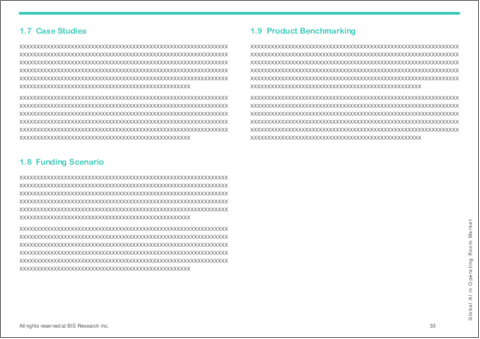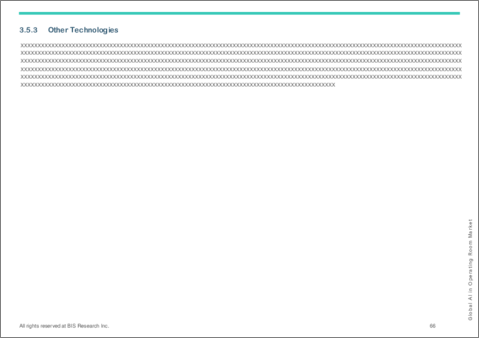|
|
市場調査レポート
商品コード
1401765
手術室向けAIの世界市場 (2023~2033年):提供区分・技術・適応症・用途・エンドユーザー別の分析・予測・アンメット需要・費用対効果の分析・国別データ (16カ国超)Global Artificial Intelligence (AI) in Operating Room Market: Focus on Offering, Technology, Indication, Application, End User, Unmet Demand, Cost-Benefit Analysis, and Over 16 Countries' Data - Analysis and Forecast, 2023-2033 |
||||||
|
● お客様のご希望に応じて、既存データの加工や未掲載情報(例:国別セグメント)の追加などの対応が可能です。 詳細はお問い合わせください。 |
|||||||
| 手術室向けAIの世界市場 (2023~2033年):提供区分・技術・適応症・用途・エンドユーザー別の分析・予測・アンメット需要・費用対効果の分析・国別データ (16カ国超) |
|
出版日: 2024年01月05日
発行: BIS Research
ページ情報: 英文 116 Pages
納期: 1~5営業日
|
- 全表示
- 概要
- 図表
- 目次
世界の手術室向けAIの市場は、革新的進歩で急成長しています。
AIは急速に外科手術の分野を変容させ、患者と外科医の双方に大きな利益をもたらしています。手術室は今やデータの宝庫であり、AIによる変革の可能性が熟しています。AIはこれまで、周術期の意思決定において外科医を支援し、手術技能と安全性を向上させることが主な用途でした。しかし、手術におけるAIの可能性を完全に引き出すには、さらなる進歩が必要です。
AIアルゴリズムは、患者の医療画像やデータを分析し、解剖学的構造の詳細な3Dモデルを作成することができます。これにより外科医はより正確に手術計画を立て、合併症のリスクを減らすことができます。AIを搭載したシステムは、複雑な手術中に外科医をガイドし、リアルタイムのフィードバックと支援を提供することができます。これにより、精度の向上、組織損傷の軽減、手術時間の短縮が可能になります。AIは、次世代ロボット手術システムの開発において重要な役割を果たしています。これらのシステムは、従来の腹腔鏡手術よりも高い精度と制御性を提供し、患者の転帰改善につながります。
地域別では、北米が同市場の成長に大きく貢献すると見られています。これは、大手AI企業が集中していることと、特に機械学習やディープラーニングなどの分野でAI技術が急速に進歩しており、外科手術の改善に大きな可能性を示していることに起因しています。
当レポートでは、世界の手術室向けAIの市場を調査し、市場の背景・概要、市場成長への各種影響因子の分析、技術・特許の分析、ケーススタディ、市場規模の推移・予測、各種区分・主要国別の詳細分析、競合情勢、主要企業の分析などをまとめています。
目次
エグゼクティブサマリー
範囲と定義
第1章 市場:業界の展望
- 動向:現在および将来の影響評価
- 手術室向けAI市場に対する各種動向の影響
- トレンド1:VR・ARのプロトタイプ
- トレンド2:手術室でのロボティクスの普及
- トレンド3:重要な役割を担うビッグデータ
- サプライチェーンの概要
- バリューチェーン分析
- 原材料・部品の価格予測
- R&Dレビュー
- 特許出願動向 (国・企業別)
- 規制状況
- エンドユーザーの認識
- 費用便益分析
- ケーススタディ
- 資金調達シナリオ
- 製品ベンチマーキング
- 主要な世界的出来事の影響分析:COVID-19
- 市場力学:概要
- 市場促進要因
- 市場抑制要因
- 市場機会
第2章 用途
- 用途の分類
- 用途の概要
- 手術室向けAI市場 (適応症別)
- 心臓病
- 整形外科
- 泌尿器科
- 消化器科
- 神経内科
- その他
- 手術室向けAI市場 (用途別)
- トレーニング
- 診断
- 手術計画・リハビリテーション
- 結果・リスク分析
- 統合・コネクティビティ
- その他 (器具の追跡とトレーサビリティ、スケジュール設定、麻酔管理)
- 手術室向けAI市場 (エンドユーザー別)
- 病院
- その他 (外来手術センター、民間施設、独立系施設、専門施設)
第3章 製品
- 製品の分類
- 製品概要
- 手術室向けAI市場 (提供区分別)
- 市場概要
- 手術室向けAI市場 (提供区分別)
- ハードウェア別
- SaaS (Software-as-a-Service) 別
- 手術室向けAI市場 (技術別)
- 機械学習 (ML)・深層学習
- 自然言語処理 (NLP)
- その他の技術
第4章 地域
- 地域概要
- 促進要因・促進要因
- 北米
- 欧州
- アジア太平洋
- ラテンアメリカ
- 中東・アフリカ
第5章 市場:競合ベンチマーキング・企業プロファイル
- 次のフロンティア
- 地理的評価
- Activ Surgical Inc.
- Brainomix Limites
- Caresyntax Corp
- Surgalign Holdings, Inc.
- LeanTass, Inc.
- Medtronic, Plc
- Proximie
- Theartor, Inc.
- DeepOR S.A.S
第6章 調査手法
List of Figures
- Figure 1: Region/country Largest Share of Market
- Figure 2: Pricing/Cost Analysis by Region, Supply Chain
- Figure 3: Global AI in Operating Room Market, by Application, 2022, 2026, and 2033
- Figure 4: Global AI in Operating Room Market, by End User, 2022, 2026, and 2033
- Figure 5: Global AI in Operating Room Market, by Offering, 2023 and 2033
- Figure 6: Global AI in Operating Room Market, by Technology, 2023 and 2033
- Figure 7: Key Events of Global AI in Operating Room Market
- Figure 8: Supply Chain and Identifying Risks within the Supply Chain
- Figure 9: Global AI in Oerating Room Market, January 2020-December 2023
- Figure 10: Global AI in Operating Room Market, January 2020-December 2023
- Figure 11: Global AI in Operating Room Market End User Perception
- Figure 12: Impact Analysis of Market Navigating Factors
- Figure 13: Strategic Initiatives, 2020 - 2023
- Figure 14: Share of Strategic Initiatives
- Figure 15: Data Triangulation
- Figure 16: Top-Down and Bottom-Up Approach
- Figure 17: Assumptions and Limitations
List of Tables
- Table 1: Market Snapshot
- Table 2: Global AI in Operating Room Market, Opportunities, by Region
- Table 3: Global AI in Operating Room Cost-Benefit Analysis
- Table 4: Global AI in Operating Room Market, by Offering
- Table 5: Global AI in Operating Room Market, by Technology
- Table 6: AI in Operating Room Market, By Region, ($ Million), 2022-2033
- Table 7: North America AI in Operating Room Market, By End User ($ Million), 2022-2033
- Table 8: North America AI in Operating Room Market, By Offering ($ Million), 2022-2033
- Table 9: Europe AI in Operating Room Market, By End User ($ Million), 2022-2033
- Table 10: Europe AI in Operating Room Market, By Offering ($ Million), 2022-2033
- Table 11: Asia Pacific AI in Operating Room Market, By End User ($ Million), 2022-2033
- Table 12: Asia Pacific AI in Operating Room Market, By Offering ($ Million), 2022-2033
- Table 13: Latin America AI in Operating Room Market, By End User ($ Million), 2022-2033
- Table 14: Latin America AI in Operating Room Market, By Offering ($ Million), 2022-2033
- Table 15: Middle East and Africa AI in Operating Room Market, By End User ($ Million), 2022-2033
- Table 16: Middle East and Africa AI in Operating Room Market, By Offering ($ Million), 2022-2033
- Table 17: Market Share
“Global Artificial Intelligence (AI) in Operating Room Market Surges with Revolutionary Advancements.”
AI is rapidly transforming the field of surgery, bringing significant benefits to both patients and surgeons. The operating room is now a treasure trove of data, ripe for the transformative potential of Artificial Intelligence (AI). Existing AI applications primarily assist surgeons in perioperative decision-making and enhance surgical skills and safety. However, further advancements are necessary to fully unlock the potential of AI in surgery.
AI algorithms can analyze a patient's medical images and data to create detailed 3D models of their anatomy. This allows surgeons to plan procedures more precisely, reducing the risk of complications. AI-powered systems can guide surgeons during complex procedures, providing real-time feedback and assistance. This can help to improve accuracy, reduce tissue damage, and shorten operating times. AI is playing a vital role in the development of next-generation robotic surgical systems. These systems offer greater precision and control than traditional laparoscopic surgery, leading to improved outcomes for patients.
- This dynamic market includes products, such as hardware, and software-as-a-service (SaaS).
- The report delves into various factors influencing the industry, including recent trends, recent advancements, and regulatory aspects. It outlines the market segmentation based on offering technology, application, indication, end user, and region.
- Geographically, North America is poised to emerge as a major contributor to the growth of the AI in operating room market. This can be attributed to the high concentration of leading AI companies, and the rapid advancement of AI technology, particularly in areas like machine learning and deep learning, which offers significant potential for improving surgical procedures.
Key Market Players and Competition Synopsis
The companies that are profiled have been selected based on inputs gathered from primary experts and analysing company coverage, product portfolio, and market penetration.
Some of the prominent names established in this market are:
|
|
Key Questions Answered in this Report:
- How has COVID-19 impacted the adoption of AI in operating rooms for applications?
- What are the key regulations governing the AI in operating room market in key regions?
- What are the technological developments which are expected to have the maximum influence on the global AI in operating room market?
- Who are the leading players holding significant dominance in the global AI in operating room market currently?
- How do end users of AI in operating rooms perceive the technology?
- What are the key business models being followed by the key players in the market?
- What are some of the major factors which are expected to influence the growth in the adoption of AI in operating room across the globe?
Table of Contents
Executive Summary
Scope and Definition
1. Markets: Industry Outlook
- 1.1. Trends : Current and Future Impact Assessment
- 1.1.1. Impact of Trends on the Global AI in Operating Room Market
- 1.1.2. Trend 1 - Virtual Reality and Augmented Reality Prototype
- 1.1.3. Trend 2 - Increasing Penetration of Robotics in OR
- 1.1.4. Trend 3 - Big Data Assuming Pivot Role
- 1.2. Supply Chain Overview
- 1.2.1. Value Chain Analysis
- 1.2.2. Pricing Forecast for Raw Materials and Components
- 1.3. Research and Development Review
- 1.3.1. Patent Filing Trend (by Country, Company)
- 1.4. Regulatory Landscape
- 1.5. End User Perception
- 1.6. Cost Benefit Analysis
- 1.7. Case Studies
- 1.8. Funding Scenario
- 1.9. Product Benchmarking
- 1.1. Impact Analysis for Key Global Events- COVID-19
- 1.11. Market Dynamics Overview
- 1.11.1. Market Drivers
- 1.11.2. Market Restraints
- 1.11.3. Market Opportunities
2. Application
- 2.1. Application Segmentation
- 2.2. Application Summary
- 2.3. Global AI in Operating Room Market (by Indication)
- 2.3.1. Cardiology
- 2.3.2. Orthopedic
- 2.3.3. Urology
- 2.3.4. Gastroenterology
- 2.3.5. Neurology
- 2.3.6. Others
- 2.4. Global AI in Operating Room Market (by Application)
- 2.4.1. Training
- 2.4.2. Diagnosis
- 2.4.3. Surgical Planning and Rehabilitation
- 2.4.3.1. Pre-Operative
- 2.4.3.2. Intra-Operative
- 2.4.3.3. Post-Operative
- 2.4.4. Outcomes and Risk Analysis
- 2.4.5. Integration and Connectivity
- 2.4.6. Others (Instrument Tracking and Traceability, Scheduling, Anesthesia Management)
- 2.5. Global AI in Operating Room Market (by End User)
- 2.5.1. Hospital
- 2.5.2. Others (Ambulatory Surgical Centers, Private, Standalone, and Specialized Facilities)
3. Products
- 3.1. Product Segmentation
- 3.2. Product Summary
- 3.3. Global AI in Operating Room Market - (by Offering)
- 3.3.1. Market Overview
- 3.3.1.1. Analyst View
- 3.3.1. Market Overview
- 3.4. Global AI in Operating Room Market (by Offering)
- 3.4.1. By Hardware
- 3.4.2. By Software-as-a-Service (SaaS)
- 3.5. Global AI in Operating Room Market (by Technology)
- 3.5.1. Machine Learning (ML) and Deep Learning
- 3.5.2. Natural Language Processing (NLP)
- 3.5.3. Other Technologies
4. Regions
- 4.1. Regional Summary
- 4.2. Drivers and Restraints
- 4.3. North America
- 4.3.1. Regional Overview
- 4.3.2. Driving Factors for Market Growth
- 4.3.3. Factors Challenging the Market
- 4.3.4. Application
- 4.3.5. Product
- 4.3.6. U.S.
- 4.3.7. Canada
- 4.4. Europe
- 4.4.1. Regional Overview
- 4.4.2. Driving Factors for Market Growth
- 4.4.3. Factors Challenging the Market
- 4.4.4. Application
- 4.4.5. Product
- 4.4.6. France
- 4.4.7. Germany
- 4.4.8. U.K.
- 4.4.9. Italy
- 4.4.10. Spain
- 4.4.11. Nordic Countries
- 4.4.12. Rest of Europe
- 4.5. Asia Pacific
- 4.5.1. Regional Overview
- 4.5.2. Driving Factors for Market Growth
- 4.5.3. Factors Challenging the Market
- 4.5.4. Application
- 4.5.5. Product
- 4.5.6. China
- 4.5.7. India
- 4.5.8. Japan
- 4.5.9. South Korea
- 4.5.10. Australia and New Zealand
- 4.5.11. Rest-of-Asia-Pacific
- 4.6. Latin America
- 4.6.1. Regional Overview
- 4.6.2. Driving Factors for Market Growth
- 4.6.3. Factors Challenging the Market
- 4.6.4. Application
- 4.6.5. Product
- 4.6.6. Brazil
- 4.6.7. Mexico
- 4.6.8. Argentina
- 4.6.9. Rest-of-Latin America
- 4.7. The Middle East and Africa
- 4.7.1. Application
- 4.7.2. Product
5. Markets - Competitive Benchmarking & Company Profiles
- 5.1. Next Frontiers…..
- 5.2. Geographic Assessment
- 5.2.1. Activ Surgical Inc.
- 5.2.1.1. Overview
- 5.2.1.2. Top Products / Product Portfolio
- 5.2.1.3. Top Competitors
- 5.2.1.4. Target Customers
- 5.2.1.5. Key Personnel
- 5.2.1.6. Analyst View
- 5.2.1.7. Market Share
- 5.2.2. Brainomix Limites
- 5.2.2.1. Overview
- 5.2.2.2. Top Products / Product Portfolio
- 5.2.2.3. Top Competitors
- 5.2.2.4. Target Customers
- 5.2.2.5. Key Personnel
- 5.2.2.6. Analyst View
- 5.2.2.7. Market Share
- 5.2.3. Caresyntax Corp
- 5.2.3.1. Overview
- 5.2.3.2. Top Products / Product Portfolio
- 5.2.3.3. Top Competitors
- 5.2.3.4. Target Customers
- 5.2.3.5. Key Personnel
- 5.2.3.6. Analyst View
- 5.2.3.7. Market Share
- 5.2.4. Surgalign Holdings, Inc.
- 5.2.4.1. Overview
- 5.2.4.2. Top Products / Product Portfolio
- 5.2.4.3. Top Competitors
- 5.2.4.4. Target Customers
- 5.2.4.5. Key Personnel
- 5.2.4.6. Analyst View
- 5.2.4.7. Market Share
- 5.2.5. LeanTass, Inc.
- 5.2.5.1. Overview
- 5.2.5.2. Top Products / Product Portfolio
- 5.2.5.3. Top Competitors
- 5.2.5.4. Target Customers
- 5.2.5.5. Key Personnel
- 5.2.5.6. Analyst View
- 5.2.5.7. Market Share
- 5.2.6. Medtronic, Plc
- 5.2.6.1. Overview
- 5.2.6.2. Top Products / Product Portfolio
- 5.2.6.3. Top Competitors
- 5.2.6.4. Target Customers
- 5.2.6.5. Key Personnel
- 5.2.6.6. Analyst View
- 5.2.6.7. Market Share
- 5.2.7. Proximie
- 5.2.7.1. Overview
- 5.2.7.2. Top Products / Product Portfolio
- 5.2.7.3. Top Competitors
- 5.2.7.4. Target Customers
- 5.2.7.5. Key Personnel
- 5.2.7.6. Analyst View
- 5.2.7.7. Market Share
- 5.2.8. Theartor, Inc.
- 5.2.8.1. Overview
- 5.2.8.2. Top Products / Product Portfolio
- 5.2.8.3. Top Competitors
- 5.2.8.4. Target Customers
- 5.2.8.5. Key Personnel
- 5.2.8.6. Analyst View
- 5.2.8.7. Market Share
- 5.2.9. DeepOR S.A.S
- 5.2.9.1. Overview
- 5.2.9.2. Top Products / Product Portfolio
- 5.2.9.3. Top Competitors
- 5.2.9.4. Target Customers
- 5.2.9.5. Key Personnel
- 5.2.9.6. Analyst View
- 5.2.9.7. Market Share
- 5.2.1. Activ Surgical Inc.
6. Research Methodology
- 6.1. Data Sources
- 6.1.1. Primary Data Sources
- 6.1.2. Secondary Data Sources
- 6.1.3. Data Triangulation
- 6.2. Market Estimation and Forecast




